Close reading poster and bookmarks
This post contains affiliate links. As an Amazon Associate I earn from qualifying purchases.
Close reading is one of those large fizz words in literacy educational activity. But what is close reading, anyway? This post will tell you exactly what it is, plus how to teach it!
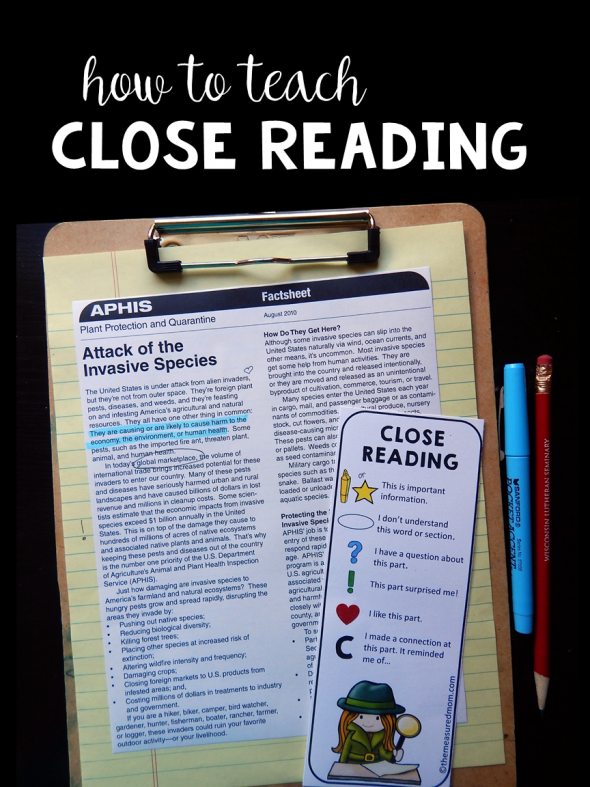
Have y'all heard the term close reading? If yous're not sure what information technology means, you're in skilful company.
Maybe this definition will help: "The principal objective of shut reading is to afford students with the opportunity to assimilate new textual information with their existing groundwork knowledge and prior experiences to expand their schema." -Douglas Fisher & Nancy Frey
Woah!
Let's simplify.
What is close reading?
Close reading is a strategy in which children read and reread brusque, complex texts to ameliorate comprehension.
Even simpler?
Shut reading is reading a text enough times that you can explicate it to someone else and answer questions about it.
What's the point of close reading?
Students will not always take a parent or teacher alongside them when tackling a tough text. Close reading gives them the tools to read complex texts all on their own.
What's the process for close reading?
Y'all'll find a different prepare of steps everywhere you look! I find the following procedure a good starting indicate for children in grades 3-6.
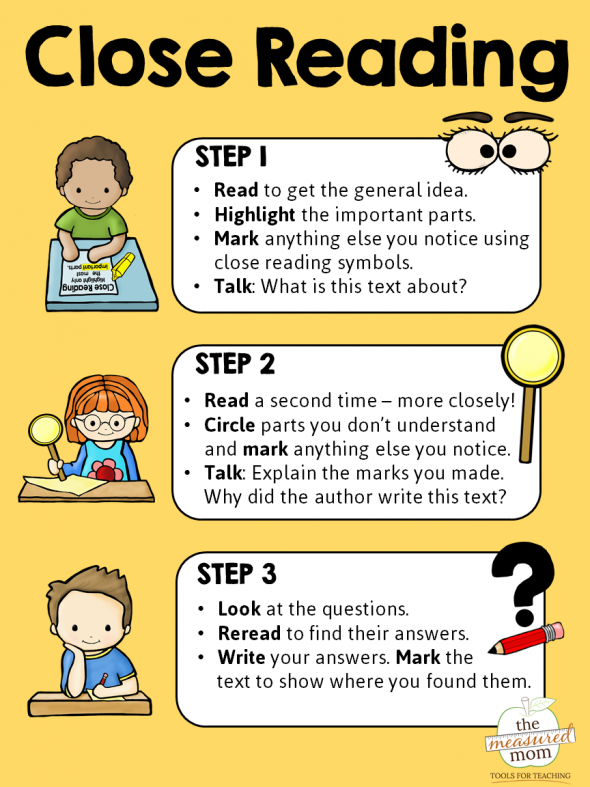
Tips for educational activity close reading
- Model get-go!
- Brand certain the text is above your students' regular reading level, simply non so much that every sentence is difficult.
- Don't give your students a lot of background knowledge before they read. Set up a purpose for reading, and leave it at that.
- Make sure your students take a chance to marking up the text with a highlighter and pencil. If they may not write on the text, provide small-scale viscid notes.
- Enquire questions whose answers your students can discover inside the text.
- Contain discussion. Suspension after each step for students to talk to a partner or small group.
- Exist patient. Close reading isn't easy! Information technology takes a lot of exercise to think critically well-nigh a text.
- Don't overdo it! Students need many opportunities to practice shut reading, just if you practice it too often yous'll wear them out.

Close reading is far from a simple chore, but don't be afraid to try it! Today I'thousand sharing a fix of gratis close reading bookmarks and a close reading lesson to give you the confidence yous demand.
How to teach a close reading lesson
one. Choose your text.
My daughter is a strong fourth form reader, and then I knew I'd need to expect higher up her grade level to observe a text that would challenge her. We used an interesting factsheet from the gratuitous Hungry Pests Invade Center School curriculum. This curriculum is designed to heighten sensation about nineteen invasive species that destroy copse and plants, threaten our food supply, and more.
The United States Department of Agriculture's Beast and Found Wellness Inspection Service has provided this standards-based curriculum for teachers of grades six-8, but y'all'll detect that you can alter many of the activities for younger grades.
2. Gather your materials.
I printed the factsheet and trimmed its edges before I glued it to a sheet of yellow legal paper, since it's helpful for kids to have a border on which to write annotations. I also grabbed a highlighter, pencil, and close reading bookmark.
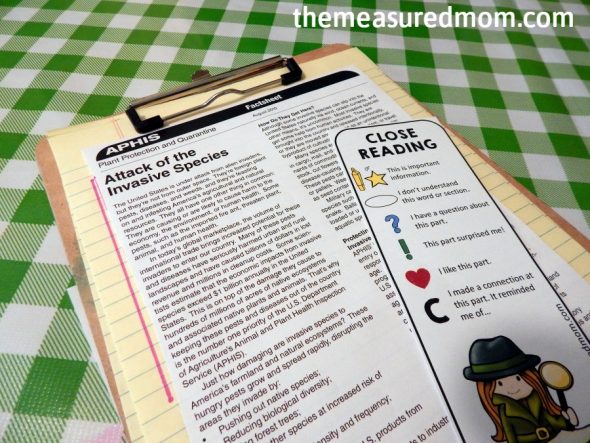
3. Explain the purpose of close reading.
With our materials in front of us, I explained what we were going to practise.
"Do you know how some things are easy to read, and other things aren't? Sometimes you accept to read something quite a few times to understand it. I feel that style when I'm reading something technical about blogging, or when I'm doing research near how to be a improve teacher. Equally you get older, you'll be doing enquiry for reports and discover that some of the text is hard for you to sympathise. Today I'm going to teach you a strategy that volition help you lot with those harder texts. Information technology's called shut reading. We're going to read the same text a few different times and exercise something different each time."
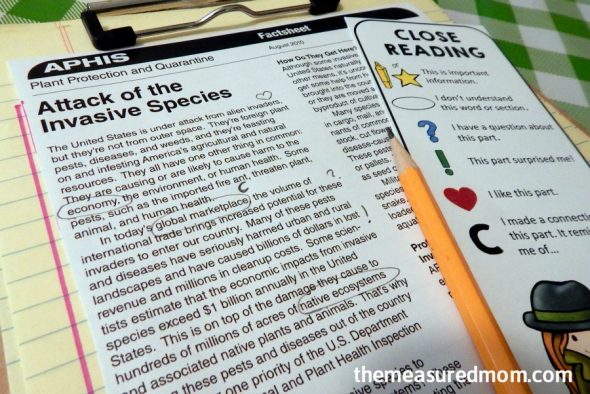
four. Model.
I read aloud the offset department of the factsheet from the Hungry Pests curriculum as a fourth grader might do it. As I read, I talked aloud about marks that I fabricated.
"The Us is under attack from conflicting invaders, merely they're non from outer infinite. (That'southward funny! I'm going to put a heart here considering I like this part.)… They are causing or are likely to crusade harm to the economy, the surroundings, or man health. (I can't think what the economy is. I'm going to circumvolve that word.)… Some pests, such every bit the imported fire ant, threaten plant, animal, and human health. (Oh, I know about fire ants! I'll put a 'C' at that place because I can make a connexion.)"
And then on.
After I read, I stated the point of the article.
"It sounds like certain bugs and weeds toll our country a lot of money when they go to the wrong places."
I read it a second fourth dimension, for a different purpose.
"I'm going to read this part once more. That will aid me understand it a little better. I'll mark anything else I notice and think well-nigh why the author wrote this article."
I read the piece a second time.
"Information technology sounds like invasive species are a really big trouble for country. The writer is writing about information technology because he wants u.s.a. to know most the problem. I think that the residual of the commodity might tell how we can prevent information technology."

4. Requite your students a chance to try information technology.
I told my girl to read the next section, and I showed her what annotations she might make using her close reading bookmark every bit a guide.
"Now it's your turn! I desire you lot to read this adjacent section. It's okay if you don't know for sure what'due south important. But highlight or star what you think are the important parts. Circle words you lot don't know or parts that are confusing. Write a '?' if yous have a question, a '!' if you lot're surprised, a heart if yous similar something, and a 'C' if it reminds you of something."
5. Support as needed.
Since this was my girl'southward first time doing a close read exercise, she needed a lot of support and reminders. She read without making any annotations at outset; I reminded her to support and highlight the important parts.
After she read the beginning fourth dimension, nosotros talked about the marks she made and why. And then, I told her to read the section another time.
"It's fourth dimension to read this a second time. Imagine that yous're reading with a magnifying glass. Yous're trying to learn even more than you learned the offset fourth dimension. As you read, feel complimentary to make more marks. I also desire you to think about why the author wrote this."
vi. Provide opportunities for discussion.
In a classroom, I'd have students run into in pairs to talk after each reading. Since information technology was just my girl and I, we talked together after each reading.
"Why exercise you think the author wrote this?"
"So that we know that invasive pests are a big problem and then we do something about it."

7. Brand sure you lot inquire text-dependent questions after the 2d reading.
We continued the procedure through several sections of text. After studying the section How practice They Get Here? I asked, "How practise Hungry Pests travel?"
She reread the text to herself and answered, "They become here on accident. They come up in the mail. They can travel on flowers and timber."
After studyingWhat you can do to fight these invaders? I asked, "How tin can y'all – a fourth grader – fight the invasion of Hungry Pests?"
"I tin can study when I see Hungry Pests. I can brand sure we don't move firewood when we go camping. I tin can make sure I don't walk through infested areas.
"And how tin you know when you see Hungry Pests or infested areas?"
"I guess I'd take to acquire what they look like."
"That's true! I accept some pictures of Hungry Pests that come with this curriculum. We can expect at those later."
8. Finish past having your students paraphrase the text.
Later on our intense reading session, I asked, "What did yous learn today?"
With some prompting she answered, "Hungry Pests cause a lot of damage. We should try to stop them from spreading."
And now you're set to try a close reading lesson!
*Fisher, Douglas & Frey, Nancy. (2012). Shut Reading in Elementary Schools.The Reading Teacher, Volume 66. p. 179-188.

Get your free close reading printables!
BUILD COMPREHENSION WITH OUR RESPONSE PACK!
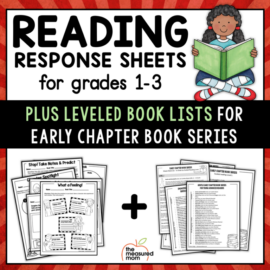
$xviii.00
Help your readers find chapter books they'll love with these leveled volume lists. Then use the 75 reading response sheets to help them make sense of what they read. The response sheets focus on grapheme, setting, plot, and vocabulary.
Source: https://www.themeasuredmom.com/what-is-close-reading/
0 Response to "Close reading poster and bookmarks"
Post a Comment